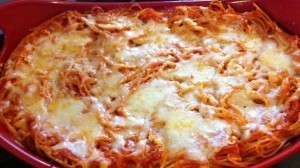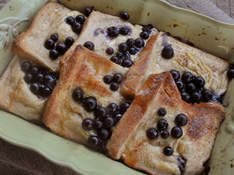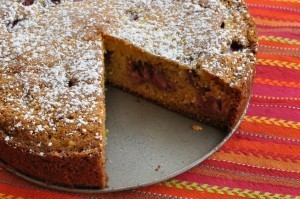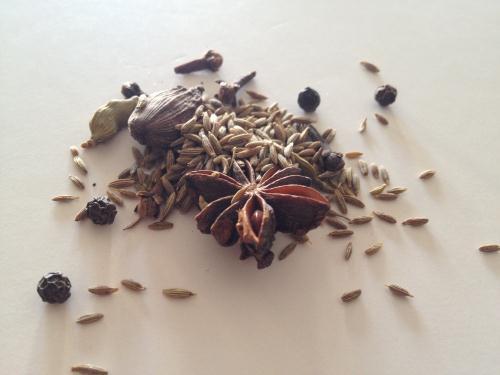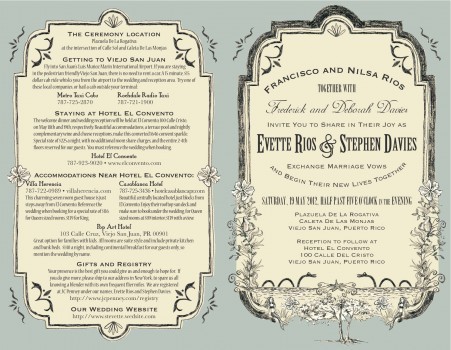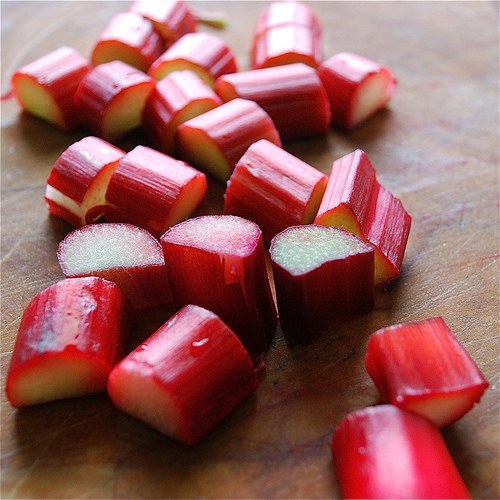Rachael Ray's Blog, page 96
May 7, 2012
The Bare-Bones BBQ: A Contest and a Manifesto
This blog, strictly speaking, is for home cookers; competition barbecuers are another breed of person, half-mad from the smell of smoke and meat, and lusting for a glory that is all-too-elusive, even for the masters of the game. But that game has become corrupt. It’s become about specialty equipment, about pellet cookers and automated fans, remote smartphone thermostats and vacuumn tumblers. The art of smoking meat, so pristine and primal a skill, has become as shrouded in fraud and technology as the meat it buries in foil and margarine. It has gotten away from the true path.
I am therefore founding the Bare Bones BBQ Contest, an all-natural, back-to-basics, IROC-style skill contest. It is for master barbecuers only. No special equipment is required, or allowed. This will be a purist’s contest, animistic and fundamentalist, with each cooker given identical smokers to cook on, IROC-style, along with a pile of wood, a bag of charcoal, and some meat. They bring seasonings and a thermometer and their skill in cooking. That’s it. The slogan is “Wood, Fire, Smoke, Skill.” They are given identical portions of beef and pork to cook, and they are welcome to use the seasonings of their choice. Period. The event will be held on September 22nd and 23rd at Jack London Square in Oakland, California, as part of Meatopia @ Eat Real, our inaugural Bay Area event. I’ll be giving barbecue pointers all summer here on Rachael Ray.com, and if you want to do your own contest, I’m in the process of preparing an open-source guide for how to do it. In the meantime, Here is the Bare Bones Barbecue Manifesto. It’s not so much an event announcement as a cri de couer, a passionate plea to bring back barbecue to its roots. It’s animistic and fundamentalist and not for everybody. The prize pool will be $5000, winner take all. If you don’t live on the west coast, fret not; reach out to us and we will hook you up with the basic rules. Here at Rachael Ray.com we are out to further good cooking and good eating. Here then, without further chit-chat, is our statement of purpose.
The Bare Bones Manifesto
BARBECUE, primal and profound, has been corrupted. Its essential elements are wood, meat, fire, and smoke, in a state of encounter with a barbecuer. That connection is simple and sacred, an unbroken continuity based on skill, patience, intuition, and desire. It is is uniquely and universally human, and an art that is essential to the human experience. It comes out of Eden; and it returns us to that uncorrupted state, if only for a few hours. It does not and should not require pellets, propane, vacuumn tumblers, or aluminum foil. Those objects have rightly been called crutches and, at best, are impediments and obstacles in the union between barbecuer and barbecue, between the art of cooking and the food we eat.
To go back to basics; to promote true cooking and true eating; and to give real masters of barbecue cookery a clearing to test and show their skill, in a fair and even playing field: for all these reasons Meatopia and Eat Real have joined forces to create the Bare Bones Barbecue Competition, to promote true natural barbecue and the deep arts of cooking it. The key principles are as follows:
All entrants will be issue identical “stick burning” offset-firebox smokers and cast-ironpans and trays as requested.
The only acceptable fuel is natural hardwood, and charcoals made on premise from that hardwood. A standard hardwood will be available to all teams, but they have the option of bringing their own wood.
No manufactured materials of any kind are allowed to teams, including but not limited to aluminum foil, bluetooth-equipped digital thermometers, meat glue, etc.
All voting is done by barbecue experts with a minimum of ten years of barbecue experience either as a cook, judge, or commercial pitmaster. Celebrity judges will render honorary verdicts only. A People’s Choice honor also be awarded.
In all categories, entrants may use any natural spices, herbs, seasonings, etc. they wish, as well as any sauces, mops, or glazes desired. KCBS garniture and blind-tasting protocols do not apply. Entrants can present their food in any manner they wish. Two supporting non-protein elements can accompany the meat but if cooked they must be cooked via the same means as the meat itself, i.e. via smoking or grilling
All meat must be all-natural, antibiotic- and hormone-free, and from a certified cruelty-free manufacturer. Meat, setup, and fuel will all be inspected before cooking begins.
The Bare Bones BBQ movement is presented not as a condemnation of contemporary barbecue practice, but instead as a celebration of the art of barbecue cooking, distilled down to its purest principles. We welcome all existing barbecue organizations to adopt our protocols, and we welcome all sanctioning requests.
“Lazy” Spaghetti Parm
I am usually all about making dishes completely from scratch, but last week did me in, and some corners needed to be cut. The stomach bug hit all three kids in succession over the course of five days, starting with my son who needed to be picked up from a slumber party at 2 am, and ending with my daughter who was sick in bed on her 12th birthday, while the family party in her honor continued downstairs.
My daughter’s favorite meal is from a much loved local restaurant - Chef’s - and she always orders spaghetti parm. I decided to try and make it at home in her honor, while she battled through the stomach flu upstairs. It took no time -I used a jar of prepared spaghetti sauce instead of making my own, and everyone loved it. I quickly baked some meatballs in the oven for the side, and this lazy spaghetti parm was loved by all (well, almost - my daughter enjoyed some leftovers the next day).
“Lazy” Spaghetti Parm (click here for printable recipe)
Ingredients
1 pound spaghetti or pasta shape of your choice
1 24-ounce jar of your favorite spaghetti sauce
1 1/2 cups shredded mozzarella
1/2 cup freshly grated parmesan
Directions
Preheat oven to 350 degrees. Spray a 9″ x 13″ baking dish with non-stick cooking spray. Cook pasta to about 2 minutes less than done, as it will be baked and you don’t want the pasta to be mushy. Toss drained pasta with about 1 cup of sauce. Add 1/2 of the sauced pasta to the prepared dish, and top with about 1/2 cup of tomato sauce and 1/2 of the cheeses. Add the remaining pasta and top with the rest of the sauce and cheeses. Bake for 20 minutes, or until the cheese is golden brown and bubbly. Serve with baked meatballs or sausage if desired.
May 6, 2012
Make-Ahead Mother’s Day Brunch Ideas
On Mother’s Day I think most moms would agree that time spent with their children is their ultimate gift, but let’s be honest here, a little pampering never hurts either. There’s nothing more special than honoring the women in our lives. After all, they not only raised us, they continue to hold us up every day. Spa treatments, flowers and fancy dinners are all lovely ways to show you care, but I much prefer celebrating at home with a delicious brunch. Since there are many moms in mine and my husbands family, it’s a great way to celebrate with all of them without having to split ourselves in two. Entertaining casually in my home is a great way for everyone to relax, enjoy each others company and eat delicious food.
I’m a mama too and as much as I love cooking, I don’t want to spend my special day slaving over a stove either. To keep things simple and fuss-free, I stick to easy and delicious make-ahead brunch treats so that no one really has to lift a finger come Mother’s Day. In fact, I do the prep work ahead of time so my husband and the other men in our family can handle the baking, pouring and serving while us ladies sit back and enjoy. Brunch is a great meal to entertain with for a few reasons: it has a late start time which means everyone can sleep in (MUCHO IMPORTANTO for a mama who never gets sleep!), the meal can be casual or fancy and the food can be eclectic so it’s easy to please everyone. Win. Win. Win.
Easy Make-ahead Brunch Ideas:
I love serving a signature cocktail or non-alcoholic beverage when I entertain because it makes everyone feel special and no one has to “man the bar” all day. Brunch isn’t the time to get bombed so one fruity alcoholic beverage should do. Mix up a large batch, pour it into a pretty pitcher and set it on the table alongside a few beautiful glasses. If you are so inclined, you can label it with an attractive little tag so that everyone knows what it is. This Clementine Spritzer is one of my Favorite drinks to serve to a brunch crowd. I make two batches: one with alcohol and one minus the champagne and swapping in seltzer. The kids just love this drink too and everyone agrees, this beverage is tops.
Pineapple and Clementine Sparkler (with a non-alcocholic option)
Serves 6-8
Ingredients:
2 cups freshly squeezed clementine juice, blood orange juice or any sweet citrus juice will do
1 cup pineapple juice
1 (750-milliliter) bottle Champagne or sparkling wine, chilled
Note: for non-alcoholic version, substitute an equal amount of seltzer for sparkling wine.
Make-Ahead Instructions:
In an attractive large pitcher, stir together the first two ingredients and store in the refrigerator the night before. Right before you are ready to serve, top with chilled champagne. Set pitcher alongside six attractive glasses that have been garnished with a clementine slice.
Berry Baked French Toast
Serves 6
Ingredients:
6 slices of sturdy, thick-cut white bread (about 1-inch thick)
2 teaspoons butter, for pan
8 large eggs
3 cups milk
3 tablespoons brown sugar
1 teaspoon vanilla extract
1/2 teaspoon ground cinnamon
1/2 tsp salt
1 cup blueberries
1/2 cup maple syrup
Make-Ahead Instructions:
Butter a 9×13-inch baking dish. Arrange slices on the bottom of a 9×13-inch baking dish, overlapping the slices.
In a large bowl, combine the eggs, milk, sugar, vanilla, cinnamon and salt. Whisk until blended but not too bubbly. Pour mixture over the bread slices, making sure to cover the bread evenly with the egg mixture. Gently press down bread to insure that bread is fully submerged. Sprinkle blueberries evenly over the top. Cover with foil and refrigerate for 5 hours or best overnight.
Preheat oven to 350 degrees F. Bake for 40 minutes, until puffed and lightly golden. Serve with maple syrup.
Other Delicious Brunch Ideas:
Puff Pastry Heart with Yogurt and Fresh Berries
Strawberry Sour Cream Cornmeal Cake
Christina Stanley-Salerno is a mama, recipe developer, food stylist, photographer and blogger atTakeBackYourTable.com. She loves cooking for and with her family. Life is hectic, but Christina is passionate about mealtime because she believes that family meals are the glue that holds everyone together. Creating simple, quick and healthy meals is her specialty and her trick to keeping the family meal a reality, even on busy weeknights.
Follow her on Twitter @TakeBackTables
May 4, 2012
India, a country of many cultures and curries – Part 1
This week I started my apprenticeship with Chef Hemant Mathur, co-founder of Tulsi NYC. For those of you familiar with New York City’s Indian food scene, Chef Hemant’s name needs no introduction. An envoy of the finest Indian fare, Chef Hemant is blessed with hard core culinary training from India and a ‘natural hand in cooking’ – a trait that is very hard to mimic. Since my husband and I have been stalking him for 12 years now, it is of no surprise that I was filled with gratitude when he agreed to train me in his kitchen.
I showed up, thinking I knew most of the fundamentals and was here to enhance my skills whilst learn a few bonus dishes. How wrong was I? There was a lot to learn and getting the names of the dishes right was a good place to start. I realized that I was calling everything with a sauce ‘curry’ and for me curry was always based on the ‘mother sauce’ of ginger, garlic, onions and tomatoes. After a brief kitchen tour, it became apparent that there are many different bases for a curry which went well beyond tomatoes and caramelized onions. Meat, fish, chicken and vegetables were also cooked in bases of coconut milk, lentils, yoghurt, ground blanched nuts or coriander based pesto. Furthermore, I learned that ‘curry’ is not even the correct term to refer to these dishes. In India, sauce based dishes are referred to by their designated names providing suggestion of ingredient, technique and region.
So where did this word come from? There are many stories regarding the origins of the term ‘curry’. Some believe that it came from the British Empire whilst others believe it came from the Southern Indian word ‘Kari’ which means sauce.
Either way, there are many varieties of sauce based dishes that are derived from local culture, customs and climate. I will be sharing with you my mini-series of dishes cooked in different Indian regional sauces and re-christen them with the name they go by in their land of origin.
Since a lot of this is new for me, I can’t know where I am going to if I don’t know where I am coming from. That is why, I am intentionally kicking off this series with a Punjabi chicken dish that I have eaten as a child called ‘Tariwala chicken’ or quite literally, chicken with gravy. Punjabi food, much like the culture is an embodiment of heart and life. The food sings through spice and loves through its liberal use of ‘ghee’ – clarified butter. Punjabi food is always cooked with intent to feed people who drop by to ‘say hello’ and if you show up with a full stomach, may the force be with you.
Tariwala chicken is the Northerner’s soul food. When chicken braised in a base of caramelized onions, tomatoes, chili, ginger and garlic comes together with fresh hot and fluffy phulkas (unleavened breads) what is the only possible outcome? Why of course, happiness and family bonding.
Tariwala chicken recipe
2 lbs chicken (with and without bone)
Whole masala (1 tsp. cumin seeds, 1 star anise, 3 cardamom pods, 1 black cardamom pod, 2 bay leaves)
1 tsp. black pepper
1 tsp coriander powder
¾ teaspoon of turmeric
½ tsp. chili powder
Salt (to taste)
1 ½ medium sized onions, finely diced
1 tsp garlic paste
2 tsp ginger paste
1 can crushed tomatoes and 1 fresh tomato, finely diced
½ cup of beaten plain yoghurt
1 Fresh green chili
Handful of cilantro
Juice of half a lemon
4 tbsp. grapeseed oil
Method
Heat the 4 tbsp. oil on high heat in a large pan (to avoid overcrowding), toast the whole spices. When the cumin starts to pop, add the onions. When onions start to brown, add the ginger and garlic and salt and allow for mixture to caramelize.
Add the tomatoes (both canned and fresh), coriander powder, black pepper, turmeric, red chili powder and green chili and cook until the sauce becomes jammy (like a compote) and starts to stick to the base of the pan (if necessary, add ¼ cup of water)
Once oil begins to appear on the surface of the sauce, add the chicken and coat in the sauce on high heat for 5 minutes. Pour in the beaten yoghurt and cook for an additional couple of minutes, add 1 cup of hot water, bring to a boil and then reduce to a simmer
Cook on medium heat for about 15 minutes or until chicken juices runs clear when a knife is inserted by the bone. Once the chicken is fully cooked through, remove from heat.
Splash with the lemon juice and sprinkle with fresh cilantro leaves
Serve with steamed rice, naan bread or pita
Note
This dish can be made with boneless chicken, but the bones add flavor and body to the sauce because of the gelatin
Saira Malhotra is a classically trained French chef and graduate from the French Culinary Institute. A British born Punjabi, Saira has grown up around food with her family pizza business where she helped spreading tomato sauce and smuggling cheese for her own little stash. Having studied in France and Italy and living in the Big Apple for the past 12 years, Saira has brought her European, Asian and American influences together via the palate and communicated through her food blog: www.passportpantry.com
April 30, 2012
Sunny Morning Muffins
I am always on the lookout for a new muffin recipe - I came across this newest one that looked somewhat healthy but delicious and decided to give it a try. They are chock-full of fruit - strawberries, blueberries, and banana - but I am sure they would work well swapping in any fruit you want. You could switch raspberries for the strawberries, fold in chopped apple for the blueberries - there are tons of possibilities depending on what you have on hand. As with all recipes that call for nuts, feel free to leave them out.
Sunny Morning Muffins (from a recipe by Sunny Anderson, foodnetwork.com) (click here for printable recipe)
Ingredients
1 cup strawberries, chopped
1 cup sugar, plus 2 tablespoons
1 1/2 cups flour
Pinch ground cinnamon
1/2 teaspoon baking soda
1/4 teaspoon ground nutmeg
1 teaspoon salt
1 ripe banana, mashed
2 eggs
1/4 cup canola oil
1 lemon, zested
1/2 pint blueberries
1 cup chopped walnuts
Directions
Preheat oven to 350 degrees F. In a small bowl, mix together strawberries and 2 tablespoons sugar. Let sit 15 minutes until strawberries give off juices.
In a small bowl, mix together flour, cinnamon, baking soda, nutmeg and salt. In a large bowl, whisk together the mashed banana, eggs, oil, 1 cup sugar, strawberries, and lemon zest. Mix the dry ingredients into the wet ingredients until combined. Do not over mix. Fold in blueberries and walnuts.
Scoop batter evenly into muffin cups. Bake until a toothpick inserted in center of muffin comes out with a few crumbs but not wet, about 30 minutes. Cool on a rack to room temperature. Makes 12 muffins.
Why You Should Care About the Beard Awards
This weekend (and even as I write it I begin to quiver) the whole food world, from superchefs on down to bacon bloggers, is on tenterhooks. Why? Clearly you must not live in the foodiverse, because this is the weekend of the James Beard Awards.
Now, I’ve written about the awards before, and not always in a glowing way. As was noted last year following Gabrielle Hamilton’s inexplicable Best Chef award, hype has a way of generating Beard awards, which inevitably generating more hype. That’s still true as far as it goes. But I now think that the Beard Awards are, on the whole, of signal value to the world at large, and worth paying attention to.
Full disclosure: I’m on the Awards committee and am also up for a journalism one, for this column, Friday night. (The journalism awards are the Beard’s equivalent of the technical Oscars, given on another night and rightly ignored by all media.)
So I may not be completely reliable as an objective observer of the institution. That said, it came to my rescue this past week. I was in Austin, Texas and wanted to eat a really great high-class meal. I knew where to go to get BBQ (Franklin’s) and old-time hamburgers (Dirty Martin’s.) But I wanted to see what the state of white-tablecloth dining was like, and I was only going to be able to eat one such meal. The most hyped restaurants in Austin right now are Uchi and Uchiko, two sushi restaurants, and the latter’s young Executive Chef Paul Qui, who just won Top Chef. are all anybody talks about down there right now. But A) I don’t really like Japanese food, at least in the form I encounter it here in the US, and 2) it makes no sense to go to Austin to eat Japanese fusion food. And then I remembered David Bull, who I heard about when he was nominated for the Best Chef Southwest award a few years ago. I remember looking him up, reading about his food, and making a mental note to eat it when I had the chance.
There are two things about this worth mentioning here. One is that, because the Beard Awards are voted by chefs, I tend to take them far more seriously than I do the local critics, who tend to be bowled over by whatever the newest or most expensive restaurant in town is. (The ultimate example of this was the lady in North Dakota who wrote a rave review of The Olive Garden.) Mitchell Davis of the Beard Foundation, says that the Beards are unique in the guidance they offer diners. “Without any national standard to judge or rate restaurants,” he says,, “like a Michelin guide for the entire country, i think the Beard Awards fill the void for the consumer.” Even in cities that do have big name guides, such as Michelin or Mobil, but I don’t trust them either; who knows what they think constitutes a good meal? They don’t even show pictures of the food the way Yelp does. Despite the occasional popularity spiral, the Beards are voted for by serious restaurant people; they’re the peers of the people they judge, and although that sometimes leads to an Old Guard of chefs that have coasted for years on boozy goodwill, it also proofs the award against short-term hype most of the time. The food at Congress wasn’t flashy, wasn’t farm-to-table (at least in theatrically rustic way of most such restaurants) and had neither a rock-and-roll TV chef nor the presence of exotic ingredients to overawe diners. It was just perfectly composed, intensely flavorful, grown-up cooking of the kind that bores the 20-something foodies who control restaurant buzz in most cities. David Bull spent his whole career cooking for middle-aged grandees in Dallas and Austin; of course he isn’t getting the same buzz as Paul Qui.
This isn’t to say that the Beards are without their problems as a gold standard for restaurants. As noted above, there is a fame spiral that applies, even among its most august judges - their own form of buzz, based on shared experience and a tendency to be behind the curve with new young chefs. Everyone knows this; but it’s not the worst thing in the world if a chef takes a few years to register on their radar. It’s rare that a rookie or sophomore pro athelete gets the MVP; even Michael Jordan had to wait. The very somnolence of some of the older Beard judges acts as a buzz-filter, and provides a much-needed counterweight to ephemeral clamor. As I get older (and poorer) I come to appreciate that more and more. The hot new joint will never need any help, by definition; but a Beard award - even a nomination! - is forever.
Ramps Are All The Rage!
If you’ve been to a farmer’s market lately-or taken a stroll by a hillside or stream-you may have noticed an edible plant with leaves that look like Lilly of the Valley and bulbs that smell like garlic on steroids. These are wild leeks, also known as ramps, and they are the pride of chefs and home cooks who know how to harness their powerful funk.
Ramps start to appear throughout most of the country (they don’t grow in arid climates) as soon as the frost and snow disappear at the start of spring. They have bright green leaves, pink stems, and white bulbs that look much like scallion bulbs. The leaves can be chopped and cooked briefly, while the white bulbs can be browned or sautéed like standard white or yellow onions.
Ramps have been eaten in rural areas, particularly the Appalachian Mountains, ever since people can remember. But for city folk, they’re a new discovery. It’s only in the last decade or so that I remember seeing them at the farmer’s market. Like lots of foods-stinging nettles, lamb’s quarters, and chickweed, to name a few-ramps were once a weed eaten only by knowledgeable country dwellers, but are now a gourmet item on the menu of high-end city restaurants.
So, what’s all the fuss about? Well, part of the thrill of ramps is that they’re the first green vegetable to make an appearance after months of nothing but root vegetables. But ramps really are a powerful ingredient. Because of their intense smell, ramps have a lot of flavor. They brighten up simple dishes like scrambled eggs, pasta, and mashed potatoes. They’re versatile, too, and can be used anywhere you would use garlic or onions. I would caution, however, that you shouldn’t eat them raw, unless you plan to avoid other humans for twenty-four hours, because your garlic breath will blow them away.
Here’s a simple recipe for minty ramp pesto that’s perfect to slather on fish, chicken, or vegetables before pan searing, grilling, or roasting. For the best flavor, marinate meat or vegetables in the pesto for at least an hour or as long as overnight to get the most flavor.
Ramp Pesto
1 bunch ramps
1 bunch fresh mint, stemmed
1 handful walnuts, pine nuts, or almonds
1 cup olive oil
2 tablespoons lemon juice
Salt and pepper
Wash the ramps in several changes of water to remove grit. Peel off any brown membranes around the stems, and slice off the roots and discard. Dry the ramps thoroughly and coarsely chop.
Place the ramps, mint, and nuts in the bowl of a food processor and pulse until coarsely ground. With the machine on, pour in the olive oil. The pesto should be thick and slightly chunky. Transfer to a bowl and stir in the lemon juice. Season with salt and pepper. The pesto is now ready to use on meat or vegetables.
April 28, 2012
The Jets meet the Sharks- Merging Cultures with My Destination Wedding
For me it was never a tough decision. I knew I wanted to get married in Puerto Rico. Growing up in New York City with parents born and raised there, I had heard all of the stories, how life used to be there, how they came from families that were poor, but proud and hardworking. How they didn’t have much, but everything they did have was either hand made, or fixed by hand because they could never afford anything new.
I have always tried to keep a strong tie to Puerto Rico. As a kid I would go ever summer with my parents, then as I got older I started going by myself and staying the whole summer with family and friends. In college I did a semester at Universidad Interamericana de San German in Puerto Rico so that I could get to know my PR peers. So it only seemed natural that Puerto Rico would be the place where I would make my love for my main squeeze, Stephen, official.
But what I didn’t realize while I was daydreaming about the super Latin wedding I was going to have in idilic Viejo San Juan, was that the love of my life, Stephen, was going to be a nice, white, mid-western boy.
Sure. Race doesn’t matter, for me it never has. (You could have filled the seats in the United Nations with all of the different people I have dated. The toughest was Muhammed, during Ramadan. I could never get used to the no eating until sunset thing.)
But, it still kind of does. Especially when it comes to a wedding. Puerto Ricans are a rare breed, my family included. They will jokingly refer to people’s short comings, saying things like, “ven aca gorda!” or in English, “come here fat one”, is something totally ok to say to your little chunky cousin, or the fat lady on the corner. If you are blind they will call you “el ciego”, “the blind one”, and if you are dark, you will get called, “el negro” “the black one”. This is all meant with all due respect, but is something that I have never, ever, encountered in Michigan, where Stephen’s family is from.
Stephen’s family comes from a long line of European ancestors. He is the classic, White, American mutt with a family lineage that goes waayyy back to England but also to Scotland, Ukraine and Poland.
His family, the Davies/Davidsons are smart and well read but also incredibly polite and in some ways, not so upfront. They will go to great lengths not to make anyone feel different, weird or out of place. I can imagine that Stephen’s mom could have an entire conversation with conjoined twins without ever saying to them “Oh, I didn’t even realize that you two were sisters.” They are just those people. Salt of the earth types.
Me and My Mom in the Kitchen!
My and My Dad After Working On Our Treehouse!
My family, is the complete opposite. We point out the obvious, we yell, we argue, we cry, we scream, we make fun of each other, we dance, we cook, we eat, we yell some more. In his family, they talk, they debate, they read, they write, they research, they cook, they eat and they nap. So making these seemingly different people comfortable at our wedding has been a worthy challenge. Here are some of the things that I am incorporating to make our wedding as enjoyable as possible for our families, old and new.
Keep it Bilingual
We are doing everything, for the most part, bilingually. This is so important when you are blending too cultures, even if a good chunk of the family speaks perfectly good English, like mine does, I feel that it is important to give a nod to where you came from through language. It sets the tone for the event and says, we are merging here, blending if you will. But no one culture is going to be more important than the other. Here are our invites. We tried to include Spanish wherever possible!
The FRONG and BACK of our Wedding Invitation
The INSIDE of our wedding invitation- A MAP!
The Outside of the RSVP card- In Spanish & English
Choose a location where you don’t have to be a local to get around.
There is a reason that tourists love Viejo San Juan, for example, because it is insanely beautiful and incredibly historic. Don’t let an area being a tourist “hot spot” dissuade you from choosing a wedding location. Remember, your new family are essentially tourists, they’re only for your wedding. (They are not real Puerto Ricans until they have passed out after drinking too many rum coconuts at my Abuela Flor’s coercion).
The Streets of Viejo San Juan
Include BOTH families as much as possible.
My family is going to feel snug as a bug being back in PR and family that lives there basically just rolled out of bed and made it over to the wedding, so the focus has to be on how to make your visiting family feel included. It is for that reason that we asked Stephen’s aunt, who is an Episcopal deacon, to marry us. My mom wasn’t too thrilled that I wasn’t getting married Catholic, and in a church, but the ceremony is going to mean so much more to have her marry us. She is like Stephen’s second mom and he loves her dearly (we will have one of my family translate too).
Make it a buffet!
Nothing is more impressive than having a huge spread of ethnic eats. It is one sure fire way to introduce your new family to your culture. Having a buffet also ensures that people can eat what they want to eat, a sit down dinner means your forced to eat what you’ve got, even if it is too spicy or your allergic to it.
Make sure everyone has something to eat!
When you are dealing with so many different types of people, with very different dietary restrictions, it is important to make sure that everyone has something to chew on! We are taking into account Aunt Bev’s peanut allergy, my Prima, Wanda’s gluten free diet, my Tio’s lactose intolerance, and my own vegetarian-ness.
Keep the food typical but with the spicy stuff on the side. In Puerto Rico, we like our food hot, both in temperature and in spice, but some people may not want to have their heads explode from so much heat. So we are putting additional mojo, and pique, the garlic and olive oil sauce and hot sauce on the side so people can make things as spicy as they need to be.
Remember your families are getting married too so make sure that each side feels safe, comfortable and equal.
Wish me luck on the big day!!!
Hopefully we will have THIS much fun at OUR wedding!
Find me on Facebook!
April 27, 2012
Rach’s New Product Videos
we love to hear Rach talk about how she came up with the designs of her products. Here she talks about the two or three essential pans everyone needs. See our Video page for all of her product vids.
Rhubarb: It’s Not Just for Dessert!
Rhubarb is back in season. I got my first bunch of it last weekend at New York’s Union Square farmer’s market. The sweet-tart smell of it cooking makes me happy. A little cinnamon, a little sugar, and in under fifteen minutes you have a tasty compote that goes beautifully with whipped cream or Greek yogurt. But have you ever tried making rhubarb as part of a main course?
Rhubarb is a natural for pairing with meats like lamb, duck, and pork. The sourness of rhubarb helps to balance the richness of the meat and bring out the flavor, the same way that cranberry relish makes your Thanksgiving turkey taste better.
Rhubarb originally comes from the Far East. There are references to it as far back as almost three thousand years ago in China, where it was used for medicinal and culinary purposes. As rhubarb made its way west along the Silk Road, enterprising cooks from Iran to Britain added the tart vegetable-yes, it’s technically a vegetable, although we use it like a fruit-to savory stews, soups, and roasts. Somehow, after it landed in the United States via Maine and Massachusetts in the 1820’s, rhubarb got stuck being strictly a dessert component, usually hiding behind sweet strawberries in pie.
By all means, make strawberry rhubarb pie this spring, there’s nothing better! But try it as part of your main course, too. Here’s Rachael’s mouthwatering recipe for Rhubarb Chutney. It uses sweet balsamic vinegar and golden raisins to draw out the flavor of rhubarb. She pairs it with Sautéed Pork Chops and Sherry-Berry Pan Gravy. Sounds like a great warm-weather meal to me, and with a garnish of bright pink rhubarb it’s sure to look stunning!
Rachael’s Rhubarb Chutney (goes with Sautéed Pork Chops with Sherry-Berry Pan Gravy)
Ingredients
2 tablespoons butter
3 tablespoons sugar
1 tablespoon lemon juice
1/4 cup balsamic vinegar
2-3 stalks rhubarb, trimmed and chopped (about 1/2 pound)
A handful of golden raisins
Instructions
In a medium skillet over medium heat melt two tablespoons of butter. Add sugar, lemon juice and vinegar and bring to a bubble. Add rhubarb and raisins and cook 10-12 minutes, until rhubarb is tender. Turn off the heat and set aside until the pork chops are done.
Rachael Ray's Blog
- Rachael Ray's profile
- 296 followers


